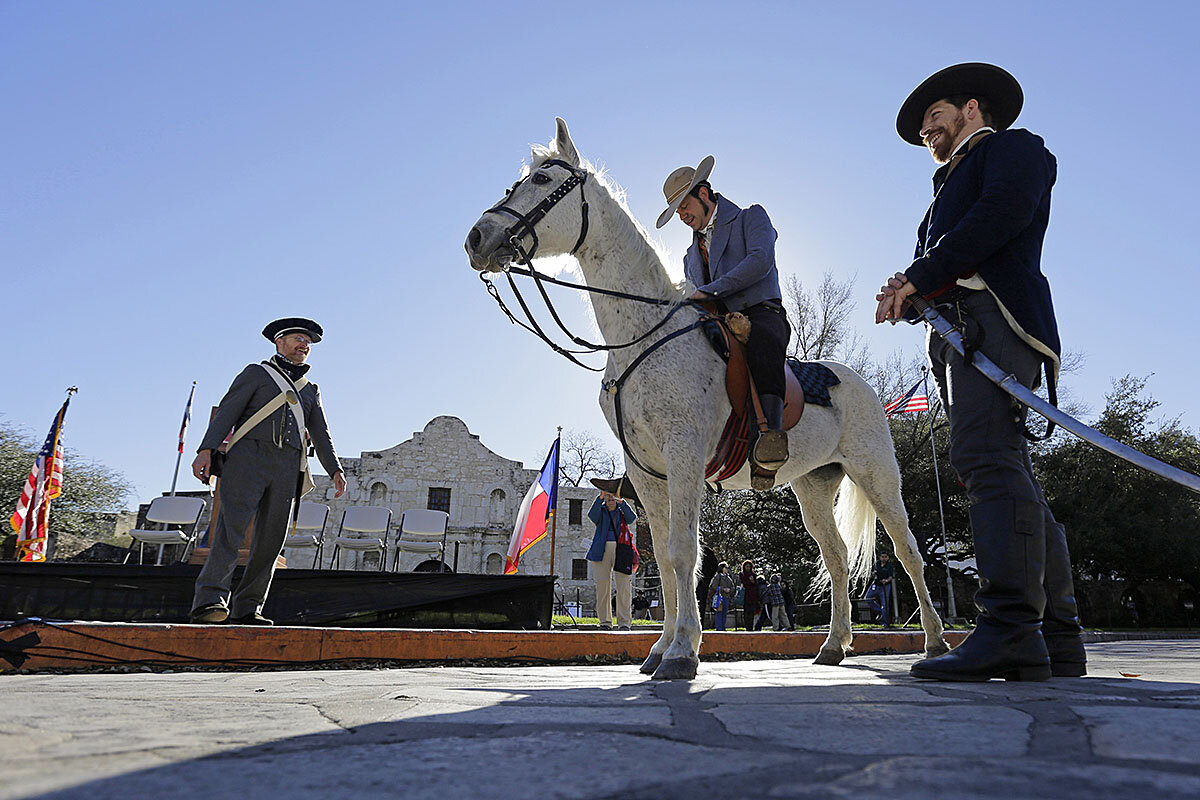In Alamo redesign, renewed battles over who gets to tell stories of Texas
Loading...
| San Antonio
Everything is bigger in Texas, they say. Everything except the Alamo, that is.
The Spanish Mission-turned-fort was about three times its current size when “Texian” revolutionaries died defending it in 1836. All that remains is a chapel, the first floor of a long barrack, and gardens full of live oak trees.
As the ruins were repurposed to a military depot, then a grocery store, and now a museum, San Antonio has filled the vacant space. The Alamo Plaza is now a place where history and modernity battle for attention. Souvenir t-shirts are sold next to 18th century Native American lodgings. William Travis, the commander of the Alamo, died near what is now a Guinness World Records museum. The Texians mounted their biggest cannon near a Ripley’s Believe It or Not! Odditorium.
Why We Wrote This
It’s not often that a community gets the chance to redefine its symbols and decide who and what’s important. San Antonians are reflecting on a newly approved plan for its iconic site.
But that could soon change as well, as local and state government officials are forging ahead with a sweeping redesign of the Alamo Plaza that was .
An overarching goal of the redevelopment, known formally as the Alamo Master Plan, is to display the history of the site beyond the legendary siege and battle. The plan also aims to make the area more “reverent” – it wants to close the area to traffic, build a new museum, and recreate the original mission footprint, among other things.
But given the scope of the changes – and the historical, cultural, and emotional weight of the Alamo itself – the multimillion-dollar Master Plan has ignited an impassioned debate over how the story of Texas’s creation myth should be told, and what (and how) other stories should be told with it. The plan’s proponents hope the redesigned Alamo will provide a broader history that better encapsulates the state’s diversity and complexity. Critics are hoping that certain stories don’t get buried in the process.
A century ago, the debate was over whether to preserve the Alamo at all. The Daughters of the Republic of Texas (DRT) won that “second battle of the Alamo.” Now the third battle of the Alamo is being fought, says Frank de la Teja, a history professor at Texas State University in San Marcos.
“What does the place represent? We’ve decided it’s worth salvaging, but what do we salvage it for?” he adds. “It’s an ongoing process of resolving these cultural conflicts, and the Alamo represents that at this moment.”
History overlooked
One thing practically everyone agrees on is that Alamo Plaza as it’s composed right now distracts from the Alamo itself. Even on a cold, rainy afternoon last week there was some evidence of that.
A steady stream of cars and buses drove by as tourists walked around, taking selfies and reading plaques. A few suited businessmen passed through as well. Three Jehovah’s Witnesses stood near a bandstand as “You Can’t Hurry Love” by Phil Collins drifted out of the Odditorium. At one section, tourists and locals walk between the Plaza and the popular San Antonio River Walk.
Few notice that the area doubles as an exhibit for the small quarters Native Americans lived in during the 18th century Mission era, with small stacks of adobe bricks from the original buildings surrounding a sign describing the history. Around the Plaza are several white-paint markings highlighting the original Mission footprint and its history. Outside the iconic Alamo chapel, near a cart renting audio tour guides, are the words “Known Burial Grounds.”
“People know the Alamo before they know San Antonio,” says Roberto Treviño, a city councilor who has been working on the redesign process since 2014. “But there are generations of people who don’t fully know the stories at the Alamo. That’s at heart of what we’re trying to do.”
Some pivotal historical events aren’t mentioned anywhere. Two businessmen used the Plaza in 1876 for the first ever demonstration of barbed wire, which would go on to transform the American West. In 1960, the Woolworth’s lunch counter across from the Alamo became one of the first businesses in the city to desegregate.
“What happened [at the Woolworth] had more impact on my generation than what happened at the battle of the Alamo,” says Sarah Gould, a historian and director of the planned Museo del Westside in San Antonio.
A battle ‘diluted’?
Broadening the views and perspectives in Texas history is something officials and academics in the state have been working on for a while, and the Alamo is no exception. Details of the pre-colonial and Mission history of the site, as well as some of its 20th century history and the DRT’s restoration work, have been added in recent years.
But the Master Plan aims to broaden Alamo history to a degree that makes many people uncomfortable. More inclusive, equitable history is good, some argue, but an exception should be made for a site as popular and iconic as the Alamo.
Specifically, people are concerned that the redesigned Alamo will downplay the 1836 battle. Those fears have coalesced into vociferous opposition to one feature of the plan: moving the Cenotaph – a 60-foot-tall concrete and marble monument erected in 1940 to memorialize the defenders – 500 feet south and outside the mission footprint.
Descendants have said that moving the Cenotaph would be like digging up their ancestors. But some see something more.
The Alamo “was the only mission that witnessed an epic battle. Why discount that? Why downplay the battle? And why rob the Alamo of its distinctiveness?” says Stephen Hardin, a history professor at McMurry University in Abilene, Texas.“They are not trying to reimagine the Alamo,” he adds. “What they want to do is redefine the Alamo.”
Lee Spencer White – founder and president of the Alamo Defenders Descendants Association, who opposes moving the Cenotaph – says she supports telling a more diverse story at the Alamo, but that she wants the story of the 1836 battle to receive the greatest emphasis.
“The 1836 battle is the defining moment in that site, whether you like it or not, whether you think it’s fair or not,” she adds.“You don’t need to take away the [1836] defenders in order to tell the other stories,” she continues. “I don’t want that diluted.”
‘Cultural memory’
To be sure, it is because of the 1836 battle that the Alamo is a world-famous tourist destination. But scholars argue that visitors are likely more familiar with the romantic myth of the Alamo than the actual history.
In his 2002 book, Richard Flores, a University of Texas anthropologist, writes that the Alamo is seen in “cultural memory … those aspects of memory that exist outside of official historical discourse, yet are ‘entangled’ with them.”
In 1905, the DRT began to restore the Alamo site, making it a shrine to the 1836 defenders. Since then the story of the siege has predominated. Dime novels and films like John Wayne’s “The Alamo” reinforced the narrative of heroic white frontiersmen like Jim Bowie and Davy Crockett falling to a Mexican horde.
But while that narrative has inspired and empowered some, it has alienated and disturbed others, much like other conflicts over controversial histories.
Several critics of moving the Cenotaph, for example, pointed out that Councilman Treviño led a successful effort to remove a Confederate statue in the city. that the mother of former San Antonio Mayor Julián Castro told The New York Times Magazine that as a Mexican-American child “I got the message – we were losers,” and that “I hate [the Alamo] and everything it stands for.”
That sentiment is not uncommon among Mexican-Americans in Texas. Dr. Flores opens with the story of his third-grade field trip to the Alamo, where a classmate taunted him “and the other ‘mes’kins’ ” for killing the 1836 defenders.
“Stories of the past,” he writes, “inscribe our present and shape our future.”
“As a myth of origin,” he adds, the Alamo “construes social actors in the present through a story that assures clear divisions between winners and losers, Anglos and Mexicans, Self and Other.”
Telling more stories that help break down those divisions created by the Alamo myth is “exactly what we need right now,” says Treviño.
“We can tell stories without making any one group of people feel like they’re villains,” he adds. “This is a complex story. Even our heroes are flawed, and I think it’s a time to show that humanity is complex.”
The prospect of telling those stories in a redeveloped Alamo Plaza took a big step forward with the city council vote last week – moving the Cenotaph was one of the sections approved – but the criticisms and controversies are unlikely to go away.
“How do you recognize that all of these issues are at play even while you’re recognizing the [battle] that happened there?” says Dr. de la Teja, from Texas State University.
“Hopefully,” he adds, “it can be done to the acceptance, maybe not the satisfaction, of the parties concerned.”





